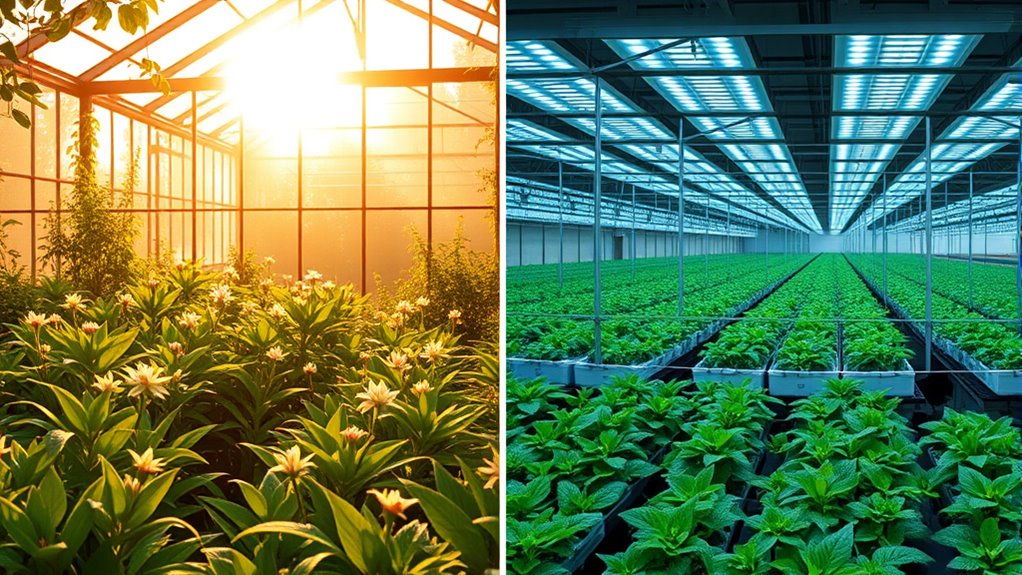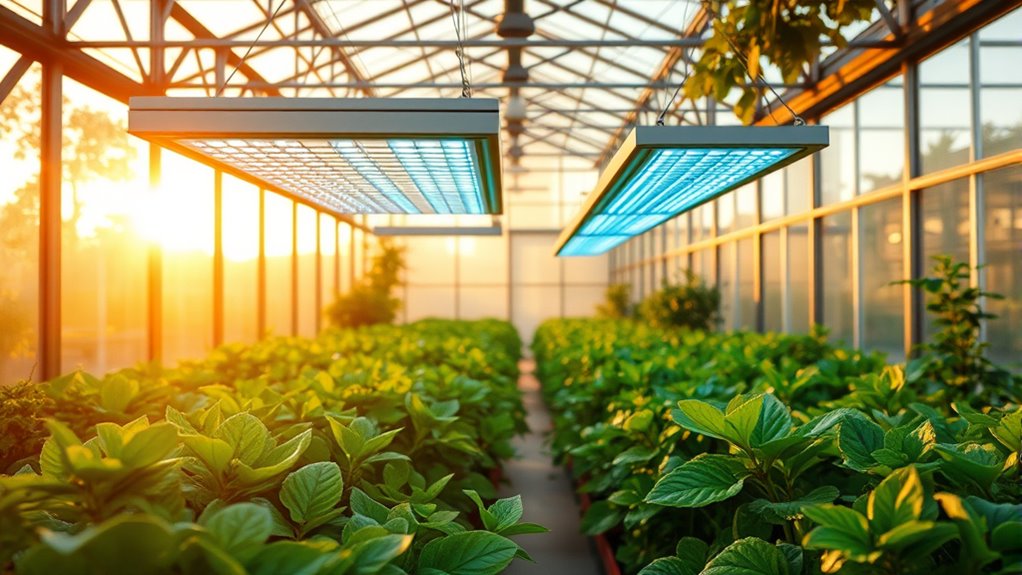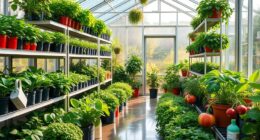To light your greenhouse effectively, combine natural sunlight with supplemental lighting like LED grow lights to guarantee plants get consistent, ideal energy throughout the year. Natural light varies with weather and seasons, so adding LED lights can fill gaps, promote healthy growth, and extend your growing season. LEDs are energy-efficient and customizable, matching specific plant needs. Keep exploring to discover how balancing both light sources can maximize your greenhouse success.
Key Takeaways
- Natural sunlight is sufficient in summer but often inadequate during winter or cloudy days, requiring supplemental lighting.
- Supplemental LED grow lights provide targeted, efficient illumination to extend growing seasons and ensure consistent plant growth.
- Customizable spectrum options allow tailoring light to plant growth stages, optimizing photosynthesis, flowering, and fruiting.
- LED lights generate less heat, enabling closer placement to plants and reducing cooling costs in the greenhouse.
- Combining natural and supplemental light maximizes energy efficiency and promotes healthier, more productive plants year-round.

Lighting your greenhouse is essential for promoting healthy plant growth, especially during shorter winter days or cloudy periods. When natural sunlight isn’t enough, supplemental lighting becomes a crucial part of maintaining ideal conditions. Among the options available, LED grow lights stand out because of their high LED efficiency. They consume less energy while providing intense, targeted illumination, which helps you save on electricity bills without sacrificing light quality. This efficiency makes LEDs a practical choice for greenhouse operators looking to extend their growing season or support plants during low-light periods.
Another key advantage of LED lighting is its customizable light spectrum. Different plant species have specific needs for various wavelengths of light, influencing processes like photosynthesis, flowering, and fruiting. LEDs allow you to tailor the light spectrum to suit your plants, delivering precise wavelengths that promote vigorous growth and higher yields. Unlike traditional lighting options, which often emit broad, less targeted light, LEDs can be programmed to emit specific colors—such as blue for vegetative growth or red for flowering—maximizing their effectiveness.
LED lighting offers customizable spectra, enhancing plant growth and yields by targeting specific wavelengths for each growth stage.
When choosing supplemental lighting, you should consider the light spectrum your plants require at different growth stages. For instance, young seedlings benefit from blue light, which encourages strong, healthy leaves, while flowering plants need more red light to produce blooms and fruit. LED systems make it easy to adjust the spectrum as your plants develop, ensuring they receive the ideal light for each stage. This precision not only boosts plant health but also improves energy efficiency because you’re providing only the wavelengths your plants need, reducing waste and unnecessary energy consumption.
In terms of LED efficiency, it’s worth noting that modern LED grow lights are much more energy-efficient than traditional options like high-pressure sodium or metal halide lamps. They generate less heat, which means you spend less on cooling systems and can place them closer to your plants without scorching them. This proximity enhances light intensity and coverage, ensuring even distribution across your greenhouse. Plus, the longer lifespan of LEDs reduces replacement costs, making them a cost-effective long-term solution.
Frequently Asked Questions
How Does Seasonal Variation Affect Greenhouse Lighting Needs?
Seasonal variation markedly impacts your greenhouse lighting needs because seasonal sunlight and daylight hours change throughout the year. During winter, shorter daylight hours mean you’ll need supplemental lighting to support plant growth. In contrast, summer offers ample natural light, reducing your reliance on artificial sources. Adjust your lighting strategies accordingly to guarantee your plants receive consistent light exposure, regardless of seasonal shifts, promoting healthy growth year-round.
Can Artificial Lights Harm Plant Growth or Health?
Artificial lights can harm your plants if you don’t choose the right light spectrum and control light intensity. Too much light or incorrect spectrum can cause stress, leaf burn, or inhibit growth. To prevent this, use grow lights designed for plants, adjust light levels appropriately, and make sure they mimic natural conditions. Properly managed artificial lighting supports healthy growth without risking plant health.
What Are Cost Differences Between Natural and Supplemental Lighting?
You’ll find natural lighting has minimal costs, mainly just initial setup like proper positioning. Supplemental lighting involves higher costs due to installation expenses, such as purchasing and setting up grow lights, plus ongoing electricity bills. Conducting a cost analysis helps you compare these expenses, considering both upfront investment and operational costs. Generally, natural light is more budget-friendly, but supplemental lighting guarantees year-round growth, especially during darker seasons.
How Do Different Plant Species Respond to Various Light Sources?
Your plants react to light sources as if they hold the secret to their growth. Different species rely on plant photoreceptors to detect the light spectrum, influencing flowering, leaf development, or fruiting. For example, some thrive in the red spectrum, while others prefer blue light. Understanding these responses helps you optimize conditions, ensuring each plant gets the perfect light spectrum for healthy, vigorous growth.
Are There Eco-Friendly Options for Supplemental Greenhouse Lighting?
Yes, you can choose eco-friendly options like solar-powered LEDs and biodegradable grow lights for supplemental greenhouse lighting. Solar-powered LEDs harness sunlight, reducing energy use and lowering your carbon footprint. Biodegradable grow lights are made from eco-friendly materials, making them a sustainable alternative. These options help you maintain ideal plant growth while minimizing environmental impact, allowing you to grow healthy plants responsibly and sustainably.
Conclusion
Think of your greenhouse as a delicate symphony that needs just the right balance of natural and supplemental light to create harmony. When you master this balance, your plants will thrive like a well-tuned orchestra, each note played perfectly. Whether harnessing the sun’s golden rays or supplementing with artificial light, you’re conducting a masterpiece. With attentive care, you’ll cultivate a vibrant, flourishing oasis—proof that the right lighting turns a simple space into a living work of art.








